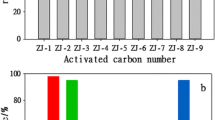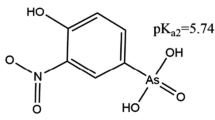Abstract
In this work, indigo carmine (IC) removal with corn cob (NCC) and KOH-treated (MCC) biomasses were studied. The removal efficiency (%R) was maximized by varying adsorbent dosages (D), initial concentrations (C0), and pHs. Therefore, D of 4 and 5 g L−1 at 50 mg L−1 of C0 and pH 2 maximized %R for NCC (70%) and MCC (71%). The KOH-based chemical modification significantly enhanced the pore sizes and the point of zero charge. Moreover, the site’s availability also increased. Chemisorption, including adsorbate-adsorbate interaction, addressed kinetics according to the pseudo-second-order and Elovich models. The Langmuir model fit well with the isotherm data suggesting that the process is thermodynamically favored for NCC. Electrostatic interactions, hydrogen bonds, and π-related interactions mainly conducted the adsorption process. The optimum adsorption capacities showed that NCC (19.87 mg·g−1) was more efficient than MCC (15.59 mg·g−1) and several reported biomass-based adsorbents. These results suggest that corn cob biomass is a promising low-cost adsorbent to bioremediate IC.









Similar content being viewed by others
References
O. Erenstein, M. Jaleta, K. Sonder, K. Mottaleb, B.M. Prasanna, Global maize production, consumption and trade: trends and R&D implications. Food Secur 14(5), 1295–1319 (2022). https://doi.org/10.1007/S12571-022-01288-7
E. Santolini, A. Barbaresi, M. Bovo, D. Torreggiani, P. Tassinari, Life cycle assessment of the supply chain processes for the valorisation of corn cob. Transp Res Procedia 67, 93–99 (2022). https://doi.org/10.1016/J.TRPRO.2022.12.039
Z.T. Chong, L.S. Soh, W.F. Yong, Valorization of agriculture wastes as biosorbents for adsorption of emerging pollutants: modification, remediation and industry application. Results Eng 17, 100960 (2023). https://doi.org/10.1016/J.RINENG.2023.100960
G.T. Tee, X.Y. Gok, W.F. Yong, Adsorption of pollutants in wastewater via biosorbents, nanoparticles and magnetic biosorbents: a review. Environ Res 212, 113248 (2022). https://doi.org/10.1016/J.ENVRES.2022.113248
Y. Zhou, J. Lu, Y. Zhou, Y. Liu, Recent advances for dyes removal using novel adsorbents: a review. Environ Pollut 252, 352–365 (2019). https://doi.org/10.1016/j.envpol.2019.05.072
Y. Tang, Y. Zhao, T. Lin, Y. Li, R. Zhou, Y. Peng, Adsorption performance and mechanism of methylene blue by H3PO4 - modified corn stalks. J Environ Chem Eng 7, 103398 (2019). https://doi.org/10.1016/j.jece.2019.103398
A. Mamaní, N. Ramírez, C. Deiana, M. Giménez, F. Sardella, Highly microporous sorbents from lignocellulosic biomass: different activation routes and their application to dyes adsorption. J Environ Chem Eng 7, 103148 (2019). https://doi.org/10.1016/j.jece.2019.103148
J. Mo, Q. Yang, N. Zhang, W. Zhang, Y. Zheng, Z. Zhang, A review on agro-industrial waste (AIW) derived adsorbents for water and wastewater treatment. J Environ Manag 227, 395–405 (2018). https://doi.org/10.1016/j.jenvman.2018.08.069
C. Phaenark, T. Jantrasakul, P. Paejaroen, S. Chunchob, W. Sawangproh, Sugarcane bagasse and corn stalk biomass as a potential sorbent for the removal of Pb(II) and Cd(II) from aqueous solutions. Trends Sci 20, 6221 (2022). https://doi.org/10.48048/tis.2023.6221
M. Afzaal, S. Hameed, N.A. Abbasi, I. Liaqat, R. Rasheed, A.A. Khan, H.A. Manan, Removal of Cr (III) from wastewater by using raw and chemically modified sawdust and corn husk. Water Pract Technol 17, 1937–1958 (2022). https://doi.org/10.2166/WPT.2022.093
R. Tri Windiastuti, T. Santoso, Determination of pptimum pH and contact time from the adsorption process of Cu(II) ions by corn cob (Zea mays) biomass. J Akad Kim 9, 224–229 (2020). https://doi.org/10.22487/J24775185.2020.V9.I4.PP224-229
A. Buasri, N. Chaiyut, K. Tapang, S. Jaroensin, S. Panphrom, Equilibrium and kinetic studies of biosorption of Zn(II) ions from wastewater using modified corn cob. APCBEE Procedia 3, 60–64 (2012). https://doi.org/10.1016/J.APCBEE.2012.06.046
T. Janani, J.S. Sudarsan, K. Prasanna, Grey water recycling with corn cob as an adsorbent. AIP Conf Proc 2112 (2019). https://doi.org/10.1063/1.5112366
S.N.A.S. Ismail, W.A. Rahman, N.A.A. Rahim, N.D. Masdar, M.L. Kamal, Adsorption of malachite green dye from aqueous solution using corn cob. AIP Conf Proc 2031 (2018). https://doi.org/10.1063/1.5066992
N.L.B. Kouassi, L.D. Blonde, K.M. N’Goran, A. Trokourey, Removal of methylene blue from industrial effluents using corncob activated carbon. Int Res J Pure Appl Chem 33–44 (2022). https://doi.org/10.9734/IRJPAC/2022/V23I5789
C.N. Arenas, A. Vasco, M. Betancur, J. Daniel, Removal of indigo carmine (IC) from aqueous solution by adsorption through abrasive spherical materials made of rice husk ash (RHA). Process Saf Environ Prot 106, 224–238 (2017). https://doi.org/10.1016/j.psep.2017.01.013
Z. Harrache, M. Abbas, T. Aksil, M. Trari, Thermodynamic and kinetics studies on adsorption of indigo carmine from aqueous solution by activated carbon. Microchem J 144, 180–189 (2019). https://doi.org/10.1016/j.microc.2018.09.004
H.X. Li, B. Xu, L. Tang, J.H. Zhang, Z.G. Mao, Reductive decolorization of indigo carmine dye with Bacillus sp. MZS10. Int Biodeterior Biodegradation 103, 30–37 (2015). https://doi.org/10.1016/j.ibiod.2015.04.007
N. Khadhri, S.M. El Khames, M. Ben Mosbah, Y. Moussaoui, Batch and continuous column adsorption of indigo carmine onto activated carbon derived from date palm petiole. J Environ Chem Eng 7, 102775 (2019). https://doi.org/10.1016/j.jece.2018.11.020
M.F. Chowdhury, S. Khandaker, F. Sarker, A. Islam, M.T. Rahman, M.R. Awual, Current treatment technologies and mechanisms for removal of indigo carmine dyes from wastewater: a review. J Mol Liq 318, 114061 (2020). https://doi.org/10.1016/J.MOLLIQ.2020.114061
F.C. Wu, R.L. Tseng, High adsorption capacity NaOH-activated carbon for dye removal from aqueous solution. J Hazard Mater 152, 1256–1267 (2008). https://doi.org/10.1016/J.JHAZMAT.2007.07.109
A.N. Odogu, K. Daouda, B.B.P. Desiré, N.J. Nsami, K.J. Mbadcam, Removal of indigo carmine dye (IC) by batch adsorption method onto dried cola nut shells and its active carbon from aqueous medium. Int J Eng Sci Res Technol 5(3), 874–887 (2016). https://doi.org/10.5281/ZENODO.48382
J. Zolgharnein, F. Rajabalipour, S. Dermanaki Farahani, Indigo carmine dye adsorptive removal by polyethylene glycol-modified hydroxyapatite nanoparticles as an efficient adsorbent. Water Air Soil Pollut 234, 1–17 (2023). https://doi.org/10.1007/S11270-023-06207-W/METRICS
F.A. Adam, M.G. Ghoniem, M. Diawara, S. Rahali, B.Y. Abdulkhair, M.R. Elamin, M.A. Ben Aissa, M. Seydou, Enhanced adsorptive removal of indigo carmine dye by bismuth oxide doped MgO based adsorbents from aqueous solution: equilibrium, kinetic and computational studies. RSC Adv 12, 24786–24803 (2022). https://doi.org/10.1039/D2RA02636H
M. El-Kammah, E. Elkhatib, S. Gouveia, C. Cameselle, E. Aboukila, Enhanced removal of indigo carmine dye from textile effluent using green cost-efficient nanomaterial: adsorption, kinetics, thermodynamics and mechanisms. Sustain Chem Pharm 29, 100753 (2022). https://doi.org/10.1016/J.SCP.2022.100753
L. Hevira, R. Zilfa, J.O. Ighalo, R. Zein, Biosorption of indigo carmine from aqueous solution by Terminalia Catappa shell. J Environ Chem Eng 8, 104290 (2020). https://doi.org/10.1016/J.JECE.2020.104290
S.M. de Oliveira Brito, H.M.C. Andrade, L.F. Soares, R.P. de Azevedo, Brazil nut shells as a new biosorbent to remove methylene blue and indigo carmine from aqueous solutions. J Hazard Mater 174, 84–92 (2010). https://doi.org/10.1016/J.JHAZMAT.2009.09.020
U.R. Lakshmi, V.C. Srivastava, I.D. Mall, D.H. Lataye, Rice husk ash as an effective adsorbent: evaluation of adsorptive characteristics for Indigo Carmine dye. J Environ Manag 90, 710–720 (2009). https://doi.org/10.1016/J.JENVMAN.2008.01.002
R.M. Ferreira, N.M. de Oliveira, L.L.S. Lima, A.L.D.M. Campista, D.M.A. Stapelfeldt, Adsorption of indigo carmine on Pistia stratiotes dry biomass chemically modified. Environ Sci Pollut Res 26, 28614–28621 (2019). https://doi.org/10.1007/S11356-018-3752-X/METRICS
Minagricultura M de A y DR, Plan integral de desarrollo agropecuario y rural con enfoque territorial (Tomo II. Departamento del Atlántico, Bogotá, 2019)
S.J. Salih, A.S. Abdul Kareem, S.S. Anwer, Adsorption of anionic dyes from textile wastewater utilizing raw corncob. Heliyon 8, e10092 (2022). https://doi.org/10.1016/j.heliyon.2022.e10092
N. Cordeiro, C. Gouveia, M.J. John, Investigation of surface properties of physico-chemically modified natural fibres using inverse gas chromatography. Ind Crop Prod 33, 108–115 (2011). https://doi.org/10.1016/J.INDCROP.2010.09.008
X. Han, D. Xie, H. Song, J. Ma, Y. Zhou, J. Chen, Y. Yang, F. Huang, Estimation of chemical oxygen demand in different water systems by near-infrared spectroscopy. Ecotoxicol Environ Saf 243, 113964 (2022). https://doi.org/10.1016/j.ecoenv.2022.113964
M. Kosmulski, The pH dependent surface charging and points of zero charge. IX. Update. Adv Colloid Interf Sci 296, 102519 (2021). https://doi.org/10.1016/J.CIS.2021.102519
H.N. Tran, S.J. You, A. Hosseini-Bandegharaei, H.P. Chao, Mistakes and inconsistencies regarding adsorption of contaminants from aqueous solutions: a critical review. Water Res 120, 88–116 (2017). https://doi.org/10.1016/j.watres.2017.04.014
L. Largitte, R. Pasquier, A review of the kinetics adsorption models and their application to the adsorption of lead by an activated carbon. Chem Eng Res Des 109, 495–504 (2016). https://doi.org/10.1016/j.cherd.2016.02.006
M.P. Astuti, T. Jasemizad, L.P. Padhye, Surface modification of coconut shell activated carbon for efficient solid-phase extraction of N-nitrosodimethylamine from water. J Sep Sci 44, 618–627 (2021). https://doi.org/10.1002/JSSC.202000868
S.D. Ashrafi, H. Kamani, A.H. Mahvi, P. Taylor, Desalination and water treatment. The optimization study of direct red 81 and methylene blue adsorption on NaOH-modified rice husk. Desalin Water Treat, 37–41 (2014). https://doi.org/10.1080/19443994.2014.979329
Y. Zou, J. Fu, Z. Chen, L. Ren, The effect of microstructure on mechanical properties of corn cob. Micron 146, 103070 (2021). https://doi.org/10.1016/j.micron.2021.103070
R. Javier-Astete, J. Jimenez-Davalos, G. Zolla, Determination of hemicellulose, cellulose, holocellulose and lignin content using FTIR in Calycophyllum spruceanum (Benth.) K. Schum. and Guazuma crinita Lam. PLoS One 16, e0256559 (2021). https://doi.org/10.1371/JOURNAL.PONE.0256559
J.O. Nwadiogbu, P.A.C. Okoye, V.I. Ajiwe, N.J.N. Nnaji, Hydrophobic treatment of corn cob by acetylation: kinetics and thermodynamics studies. J Environ Chem Eng 2, 1699–1704 (2014). https://doi.org/10.1016/j.jece.2014.06.003
X. Chi, C. Liu, Y.H. Bi, G. Yu, Y. Zhang, Z. Wang, B. Li, Q. Cui, A clean and effective potassium hydroxide pretreatment of corncob residue for the enhancement of enzymatic hydrolysis at high solids loading. RSC Adv 9, 11558–11566 (2019). https://doi.org/10.1039/C9RA01555H
L. Dai, W. Zhu, J. Lu, F. Kong, C. Si, Y. Ni, A lignin-containing cellulose hydrogel for lignin fractionation. Green Chem 21, 5222–5230 (2019). https://doi.org/10.1039/C9GC01975H
W.R. Kunusa, I. Isa, L.A. Laliyo, H. Iyabu, FTIR, XRD and SEM analysis of microcrystalline cellulose (MCC) fibers from corncorbs in alkaline treatment. J Phys Conf Ser 1028, 012199 (2018). https://doi.org/10.1088/1742-6596/1028/1/012199
P. Bock, N. Gierlinger, Infrared and Raman spectra of lignin substructures: coniferyl alcohol, abietin, and coniferyl aldehyde. J Raman Spectrosc 50, 778–792 (2019). https://doi.org/10.1002/jrs.5588
T. Hong, J.Y. Yin, S.P. Nie, M.Y. Xie, Applications of infrared spectroscopy in polysaccharide structural analysis: progress, challenge and perspective. Food Chemistry X 12, 100168 (2021). https://doi.org/10.1016/J.FOCHX.2021.100168
D. Varga, L. Tolvaj, Z. Molnar, Z. Pasztory, Leaching effect of water on photodegraded hardwood species monitored by IR spectroscopy. Wood Sci Technol 54, 1407–1421 (2020). https://doi.org/10.1007/s00226-020-01204-2
M. Güler, S. Çetintaş, D. Bingöl, Cinnamon bark as low-cost and eco-friendly adsorbent for the removal of indigo carmine and malachite green dyestuffs. Int J Environ Anal Chem 101, 735–757 (2021). https://doi.org/10.1080/03067319.2019.1670171
R.E. Palma-Goyes, J. Silva-Agredo, I. González, R.A. Torres-Palma, Comparative degradation of indigo carmine by electrochemical oxidation and advanced oxidation processes. Electrochim Acta 140, 427–433 (2014). https://doi.org/10.1016/J.ELECTACTA.2014.06.096
Z. Begum, K.S. Kavi Kumar, in A Study of India’s Textile Exports and Environmental Regulations. Global environmental requirements - textile industry (2017), pp. 61–72. https://doi.org/10.1007/978-981-10-6295-7_4
M.R. Elamin, B.Y. Abdulkhair, A.O. Elzupir, Removal of ciprofloxacin and indigo carmine from water by carbon nanotubes fabricated from a low-cost precursor: solution parameters and recyclability. Ain Shams Eng J 14, 101844 (2023). https://doi.org/10.1016/J.ASEJ.2022.101844
X. Yang, G. Xu, H. Yu, Z. Zhang, Preparation of ferric-activated sludge-based adsorbent from biological sludge for tetracycline removal. Bioresour Technol 211, 566–573 (2016). https://doi.org/10.1016/j.biortech.2016.03.140
M. Benjelloun, Y. Miyah, G. Akdemir Evrendilek, F. Zerrouq, S. Lairini, Recent advances in adsorption kinetic models: their application to dye types. Arab J Chem 14, 103031 (2021). https://doi.org/10.1016/j.arabjc.2021.103031
J. Wang, X. Guo, Adsorption isotherm models: classification, physical meaning, application and solving method. Chemosphere 127279 (2020). https://doi.org/10.1016/j.chemosphere.2020.127279
Author information
Authors and Affiliations
Corresponding author
Ethics declarations
Conflict of interest
The authors declare no competing interests.
Rights and permissions
Springer Nature or its licensor (e.g. a society or other partner) holds exclusive rights to this article under a publishing agreement with the author(s) or other rightsholder(s); author self-archiving of the accepted manuscript version of this article is solely governed by the terms of such publishing agreement and applicable law.
About this article
Cite this article
Echeverría-Pérez, J., Carvajal-Palacio, W., Gómez-Plata, L. et al. Corn cobs and KOH-treated biomasses for indigo carmine removal: kinetics and isotherms. emergent mater. 6, 1217–1229 (2023). https://doi.org/10.1007/s42247-023-00526-8
Received:
Accepted:
Published:
Issue Date:
DOI: https://doi.org/10.1007/s42247-023-00526-8




